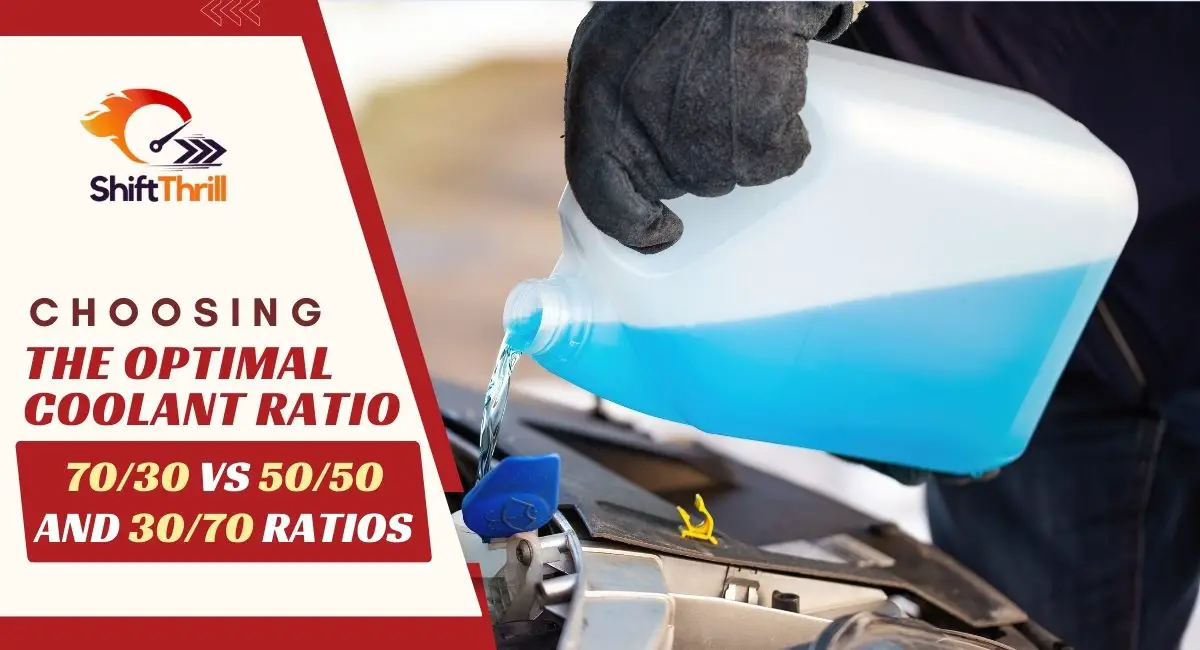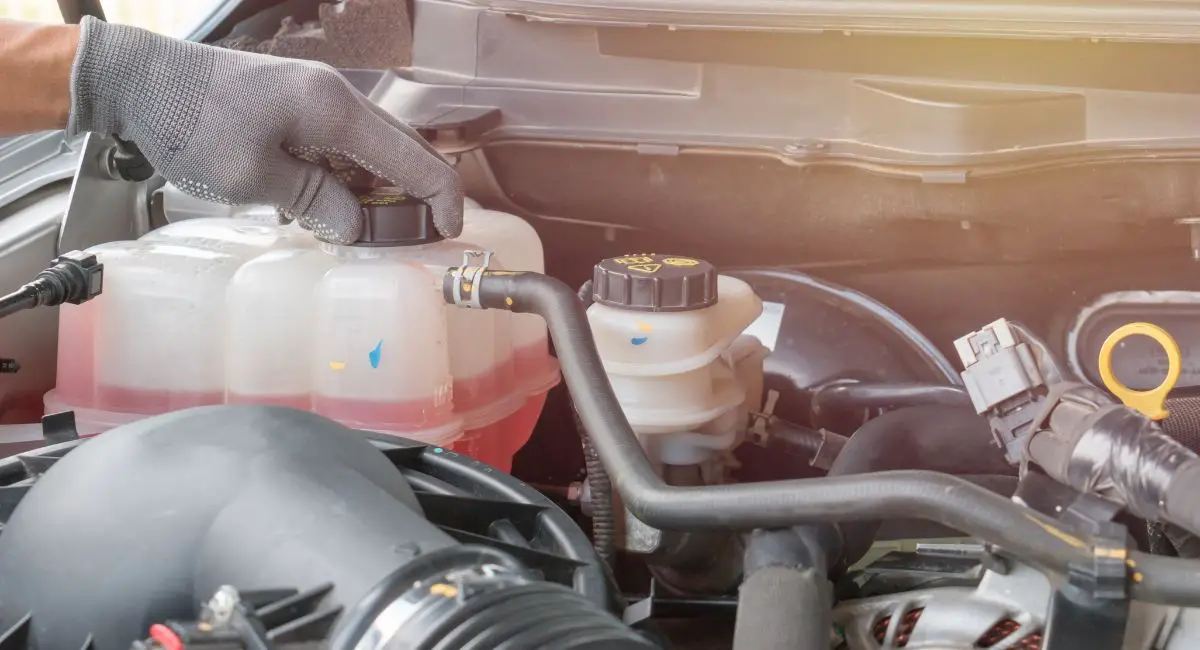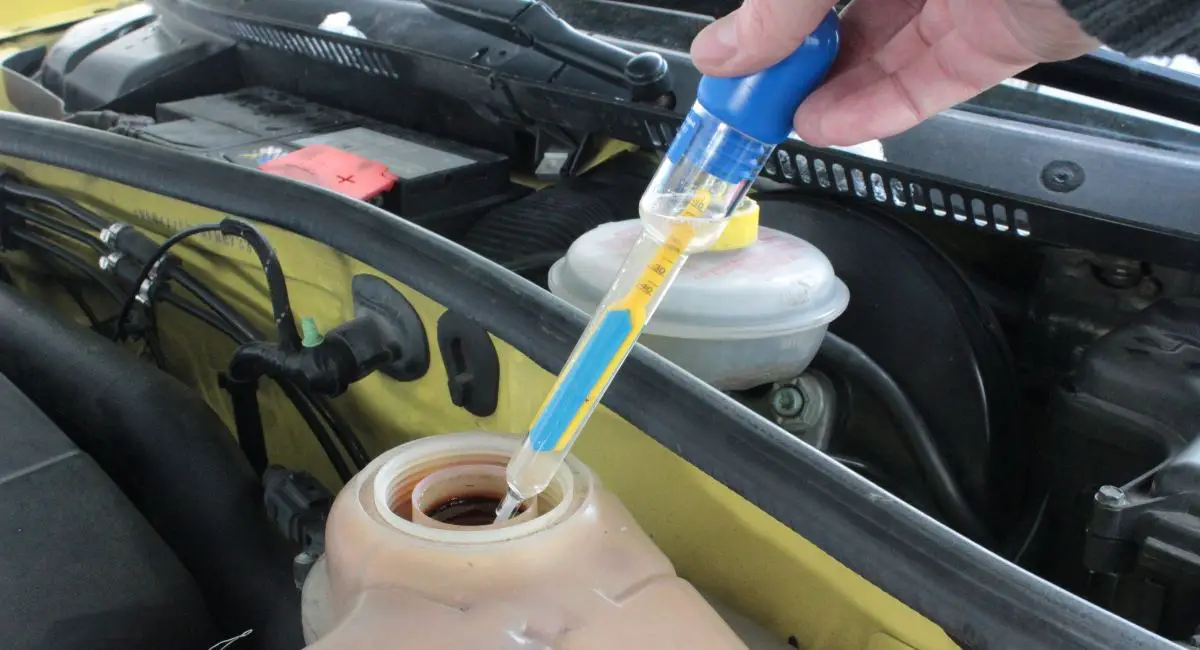As a car owner, you must have come across the terms coolant and antifreeze with the ratios—70/30,50/50, and vice versa. Are they similar, and if not, what’s the difference? Vehicle maintenance is crucial, so you need to figure this out.
A coolant is merely a mixture of antifreeze and water. It explains the variant ratios you’ve come across. On the other hand, the antifreeze, as implied by its name, is an additive for radiator fluid designed to inhibit coolant freezing. Engine coolant plays a pivotal role in regulating temperature and preventing overheating.
Now, let’s examine the specifics of coolant mixtures— the debate between 70/30 vs. 50/50 and all the other coolant ratios, examining their advantages, disadvantages, and the optimal scenarios for their application.
Understanding Antifreeze and Coolant Ratios
From the understanding you have so far, you can tell a slight difference between the coolant and antifreeze, but there’s more. With close interaction with these two fluids, you can tell them apart.
However, let me make this easier for you.
What are the Differences Between Antifreeze and Coolant
Antifreeze is a concentrated solution containing ethylene glycol or propylene glycol and additives. Its main job is to prevent the coolant from freezing in cold temperatures.
Coolant is a mixture of antifreeze and water in a specified ratio. The water is added to the concentrated antifreeze to create a coolant solution for the radiator. But what is the best coolant or antifreeze?
The primary purpose of antifreeze is to reduce the freezing point of the coolant, preventing it from solidifying in cold temperatures. Besides, this mixture of antifreeze and water circulates through the engine to regulate temperature, preventing freezing in winter and overheating in summer.
When it comes to colors, antifreeze has a bright and distinct color, often green, orange, pink, or blue, depending on the type and brand. You’ll determine the coolant’s color by the antifreeze type. When mixed with water, it retains the color of the concentrated antifreeze.
Moreover, mixing antifreeze with water before adding it to the coolant system is crucial. As time passes, the coolant in your system will accumulate impurities, leading to a loss of its original color and a gradual darkening, often manifesting as a brownish, oxidized hue.
Can Antifreeze Go Directly Into the Coolant?
No, antifreeze should not go directly into the coolant system. Mix it with water to form a coolant solution before adding it to the radiator. The recommended ratio is often 50% antifreeze and 50% water, but this may vary depending on the manufacturer’s guidelines.

What are Coolant Ratios?
It’s time to get back to the ratios. Coolant ratio refers to the proportion of coolant concentrate to water in the mixture. The most common ratios are 70/30, 50/50, and 30/70. The right balance is crucial for the engine’s efficiency and temperature control.
Let’s delve into the characteristics of each ratio to understand the coolants.
70/30 Coolant Ratio
A 70/30 coolant ratio comprises 70% coolant concentrate and 30% water. This high concentration of coolant offers several advantages.
- The 70/30 coolant ratio dissipates high heat levels, making it suitable for high-performance engines.
- Ideal for colder climates, the 70/30 mixture has a lower freezing point, preventing solidification even in freezing temperatures.
- The higher concentration of coolant in the ratio provides superior protection against corrosion, ensuring the longevity of engine components.
- The 70/30 ratio offers increased resistance against cavitation, preventing potential damage caused by bubble formation and collapse.
- When you combine heat dissipation, freezing point reduction, corrosion protection, and cavitation resistance, the 70/30 ratio contributes to a longer lifespan for the engine.
- The 70/30 coolant ratio is well-suited for engines operating in extreme conditions, ensuring practical coolant function, preventing freezing, and maintaining proper heat transfer.
However, there are downsides to this concentration.
- Higher coolant concentration may impede heat dissipation, as water is a more effective heat conductor.
- The 70/30 ratio involves more coolant concentrate, making it more expensive than diluted mixtures.
- Reduced water content may affect heat dissipation, making it less suitable for consistently hot conditions.
- Enhanced freezing protection may lead to overcooling in regions with moderate temperatures.
- Some engines and cooling systems may not be compatible with the 70/30 ratio.
- The higher concentration in the 70/30 ratio may pose environmental issues if disposed of improperly.
- While excelling in freezing protection, it may provide less effective boiling protection in extremely high-temperature conditions.

50/50 Coolant Ratio
A 50/50 coolant ratio balances coolant concentrate and water, offering a mix suitable for various climates. The even distribution ensures optimal heat transfer, making it an excellent choice for everyday use. This ratio protects freeze and boils, making it versatile for hot and cold climates.
Advantages of 50/50 Coolant Ratio
- The 50/50 ratio is versatile and suitable for various climates, offering freeze and boil protection. It makes it a practical choice for year-round use.
- Compared to higher concentrate ratios like 70/30, the 50/50 ratio is more cost-effective. It balances performance and affordability, making it a popular choice among vehicle owners.
- The balanced mixture of coolant and water in the 50/50 ratio ensures optimal heat transfer efficiency. It is well-suited for everyday driving conditions without sacrificing performance.
- The 50/50 ratio includes sufficient corrosion inhibitors, offering adequate protection against corrosion and extending the lifespan of engine components.
- The pre-mixed nature of the 50/50 ratio simplifies the coolant replacement process, eliminating the need for precise measurements during mixing.
Disadvantages of 50/50 Coolant Ratio
- The 50/50 mixture may have less heat dissipation capacity than higher concentrate ratios. It can be a consideration for high-performance engines or those operating under extreme conditions.
- The lower concentration of coolant in the 50/50 ratio may result in slightly reduced corrosion protection compared to higher concentrate mixtures.
- While versatile, the 50/50 ratio may not be optimal for vehicles operating in extremely cold or hot climates, where more specialized coolant ratios could offer better protection.
30/70 Coolant Ratio
The 30/70 coolant ratio, composed of 30% coolant concentrate and 70% water, is designed to maximize heat transfer efficiency. With a higher water content, it is suitable for engines operating in consistently warm climates, providing adequate cooling capabilities.
Advantages of 30/70 Coolant Ratio
- The higher water content in the 30/70 ratio enhances heat dissipation, making it well-suited for engines operating in consistently warm conditions.
- The lower concentrate content in the 30/70 ratio makes it a cost-effective option compared to higher concentrate mixtures, providing efficient cooling at a lower cost.
- The composition of the 30/70 ratio makes it effective in facilitating heat transfer, ensuring optimal engine performance in warmer environments.
- While not as low as higher concentrate ratios, the 30/70 mixture still offers some protection against freezing, making it suitable for regions with milder winters.
Disadvantages of 30/70 Coolant Ratio
- The lower concentrate content reduces freeze protection compared to higher concentrate ratios like 50/50 or 70/30. It makes it less suitable for freezing climates.
- The 30/70 ratio may provide less effective boiling protection in extremely high-temperature conditions than higher concentrate mixtures.
- The lower concentration of coolant in the 30/70 ratio may result in slightly reduced corrosion protection compared to higher concentrate mixtures.
- While effective in warm climates, the 30/70 ratio may need to be more versatile for vehicles that experience significant temperature fluctuations or extreme weather conditions.
A Comparison of 70/30 Vs. 50/50 Coolant Ratios
Comparing 70/30 and 50/50 coolant ratios reveals distinct characteristics. The 70/30 ratio offers superior heat dissipation, a lower freezing point, and enhanced corrosion protection but comes with a higher cost and potential reduction in heat transfer efficiency.
On the other hand, the 50/50 ratio is versatile and cost-effective, providing adequate heat transfer, albeit with slightly reduced freezing protection and less concentrated corrosion protection, and choosing between the two hinges on factors like cost considerations, climate, and the specific needs of the vehicle’s cooling system.
A Comparison of 50/50 Vs. 30/70 Coolant Ratios
In comparing 50/50 and 30/70 coolant ratios, the 50/50 mixture strikes a balance by being versatile and cost-effective, offering effective heat transfer capabilities. While it provides substantial freezing and boiling protection, the 30/70 ratio, with its higher water content, prioritizes efficient heat dissipation. It makes it suitable for engines operating in consistently warm conditions.
However, the 30/70 ratio may be less effective in freezing temperatures. The choice between these ratios depends on factors such as climate, cost considerations, and the specific requirements of the vehicle’s cooling system.

Factors Influencing Coolant Ratio Choice
Choosing the proper coolant ratio for your vehicle involves considering various factors. This decision is not one-size-fits-all; it depends on a combination of elements that can significantly impact your engine’s performance and longevity. Let’s delve into the factors that influence the coolant ratio choice:
1. Climate Considerations
A higher concentrate ratio, such as 70/30, is often preferred in regions with frigid temperatures. It lowers the freezing point, preventing the coolant from solidifying in extreme cold and ensuring the engine remains operational.
A 50/50 ratio strikes a balance and suits moderate climates, offering freeze and boil protection. It’s versatile enough to handle fluctuations in temperature without compromising efficiency.
2. Manufacturer Recommendations
Vehicle manufacturers invest significant research in determining the optimal coolant ratio for their engines. The owner’s manual usually includes specific guidelines regarding the recommended coolant mixture. Adhere to this advice to ensure optimal performance and maintain warranty validity.
3. Specific Engine Requirements
Different engines have distinct cooling system designs and specifications—some engines’ designs perform optimally with a particular coolant ratio. You must understand your vehicle’s specific requirements; adhering to them is crucial for the best results. Consult your vehicle’s technical documentation or seek advice from the manufacturer or a certified mechanic.
4. Vehicle Usage and Operating Conditions
How you use your vehicle plays a role in the coolant ratio choice. If your car frequently operates under heavy loads, such as towing or off-road driving, a coolant ratio with higher concentrate content may benefit its superior heat dissipation capabilities. On the other hand, if your vehicle is used primarily for daily commuting in less demanding conditions, a 50/50 ratio might be more suitable.
5. Personal Preferences
Some vehicle owners have personal preferences based on their experiences or recommendations from other enthusiasts. If you’ve succeeded with a particular ratio or received advice from trusted sources, that can influence your choice. However, it’s essential to balance personal preferences with the specific needs of your vehicle and its operating conditions.
6. Maintenance Habits
Consider your maintenance habits; they’re crucial. If you’re diligent about regular coolant checks and flushes, you might have more flexibility in choosing a ratio that aligns with the prevailing climate. Diligent maintenance ensures the coolant remains effective and extends the lifespan of your engine’s cooling system.
Maintenance Tips and Considerations
Maintaining your vehicle’s cooling system is crucial for optimal engine performance, longevity, and fuel efficiency. Here are some of the best maintenance tips and considerations to ensure your cooling system operates smoothly:
1. Regular Coolant Checks
Periodically check the coolant level in the reservoir when the engine is cool. Make sure that the coolant is between the minimum and maximum marks. Low coolant levels can lead to overheating.
2. Coolant Flush
Perform a coolant flush according to the manufacturer’s recommendations. Over time, coolant accumulates contaminants and loses its effectiveness. A flush helps remove these impurities and ensures the coolant’s proper functioning.
3. Monitor Coolant Color and Condition
Check the color of the coolant. It should match the color recommended by the manufacturer. If it appears discolored or has visible contaminants, it’s time for a flush. Additionally, look for signs of oil or debris in the coolant, as these may indicate more significant issues.
4. Coolant Replacement
Follow the manufacturer’s guidelines for coolant replacement intervals. Over time, coolant properties degrade, reducing its ability to protect against corrosion and overheating. Regular replacement ensures optimal performance.
5. Inspect for Leaks
Check for coolant leaks around hoses, connections, and the radiator. Leaks can lead to losing coolant, causing the engine to overheat. Repair any leaks to prevent further damage.
6. Radiator Cap Inspection
Examine the radiator cap for any indicators of wear or damage. The cap helps maintain the system’s pressure and prevents overheating. Replace the cap if it shows signs of deterioration.
7. Maintain the Cooling System Pressure
Ensure that the cooling system maintains the recommended pressure. Low pressure can result in a lower boiling point, leading to overheating. Check the pressure using a pressure tester.
8. Use the Right Coolant Mixture
Choose the correct coolant ratio based on your vehicle’s needs and operating climate. Refer to the manufacturer’s recommendations for the ideal coolant mixture.
9. Engine Belt Inspection
Examine the condition of the serpentine or accessory belt driving the water pump. A worn or damaged belt can compromise the water pump’s efficiency, affecting coolant circulation.
10. Monitor Engine Temperature
Check your vehicle’s temperature gauge. If it consistently runs hotter than usual, investigate the cause promptly. Overheating can cause engine damage if you do not address it.
11. Regular System Pressure Testing
Periodically perform a pressure test on the cooling system to identify leaks or weak points. This proactive approach can prevent unexpected cooling system failures.
12. Inspect the Thermostat
The thermostat controls the flow of coolant. In the event of a malfunction, it may lead to overheating or a decline in heating efficiency. Replace the thermostat at recommended intervals or if you notice temperature irregularities.
13. Protect Against Corrosion
Use a coolant that contains corrosion inhibitors. Corrosion can damage vital components in the cooling system, leading to leaks and reduced efficiency.
Conclusion
Choosing between 70/30 and 50/50 coolant ratios depends on climate, vehicle specs, and preferences. Each ratio has pros and cons, requiring careful consideration for the best fit. Regular maintenance, adherence to manufacturer recommendations, and understanding the coolant’s role are crucial for an efficient cooling system. The proper ratio ensures engine protection in varied conditions, from icy roads to scorching heat.
